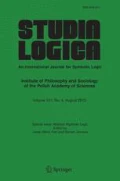Abstract
The concept of polarity is pervasive in natural language. It relates syntax, semantics and pragmatics narrowly (Giannakidou, in: Maienborn, von Heusinger, Portner (eds.), Semantics: an international handbook of natural language meaning, De Gruyter Mouton, Berlin, 2011; Israel in The grammar of polarity: pragmatics, sensitivity, and the logic of scales, Cambridge studies in linguistics, Cambridge University Press, Cambridge, 2014), it refers to items of many syntactic categories such as nouns, verbs and adverbs. Neutral polarity items appear in affirmative and negative sentences, negative polarity items cannot appear in affirmative sentences, and positive polarity items cannot appear in negative sentences. A way of reasoning in Natural Language is through Natural Logic (van Benthem in Essays in logical semantics, vol. 29 of Studies in linguistics and philosophy, Reidel, Dordrecht, 1986; Language in action: categories, lambdas, and dynamic logic, vol. 130 of Studies in logic, Elsevier, Amsterdam, 1991). This logic is based on the concept of polarity in order to make the meaning of a sentence weaker o stronger without changing its truth value. There exist many proposals to compute polarity in the Natural Logic context, the most widely known are the ones by: van Benthem (1986, 1991), Sánchez-Valencia (Studies on natural logic and categorial grammar, Ph.D. thesis, Universiteit van Amsterdam, 1991), Dowty (Proceedings of the 4th conference on semantics and theoretical linguistics, Cornel University, CLC Publications, Rochester, 1994), and van Eijck (in: ten Cate, Zeevat (eds.), 6th international Tbilisi symposium on logic, language, and computation, Batumi, Georgia, Springer, 2007). If Natural Logic is going to be used, as an inferential mechanism between text fragments, in Natural Language Processing applications such as text summarization, question answering, and information extraction, it is a priority to know what the existing relationship among the aforementioned algorithms is; for example, to implement the most general. We show in this paper the equivalence among the analyzed algorithms, filling a gap in Natural Logic research, particularly in computing polarity, and the soundness of their algorithms.
Similar content being viewed by others
References
Ajdukiewicz, K., Syntactic Connexion (1936), Springer, Dordrecht, 1978, pp. 118–139.
Bach, E., Categorial Grammars as Theories of Language, Springer, Dordrecht, 1988, pp. 17–34.
Dagan, I., O. Glickman, and B. Magnini, The Pascal recognising textual entailment challenge, in Proceedings of the First International Conference on Machine Learning Challenges: Evaluating Predictive Uncertainty Visual Object Classification, and Recognizing Textual Entailment, MLCW’05, Springer, Berlin, 2006, pp. 177–190.
Dagan, I., R. Dan, M. Sammons, and F.M. Zanzotto, Recognizing Textual Entailment: Models and Applications, Synthesis Lectures on Human Language Technologies, Morgan & Claypool Publishers, San Rafael, 2013.
Dowty, D., The role of negative polarity and concord marking in natural language reasoning, in Proceedings of the 4th Conference on Semantics and Theoretical Linguistics, Cornel University, CLC Publications, Rochester, 1994.
Giannakidou, A., Positive polarity items and negative polarity items: variation, licensing, and compositionality, in C. Maienborn, K. von Heusinger, and P. Portner (eds.), Semantics: An International Handbook of Natural Language Meaning, De Gruyter Mouton, Berlin, 2011, pp. 1660–1712.
Icard III, T.F., and L.S. Moss, Recent progress on monotonicity. Perspectives on semantic representations for textual inference, Linguistic Issues in Language Technology 9:167–194, 2014.
Israel, M., The Grammar of Polarity: Pragmatics, Sensitivity, and the Logic of Scales, Cambridge Studies in Linguistics, Cambridge University Press, Cambridge, 2011.
Karttunen, L., From natural logic to natural reasoning, in A. Gelbukh (ed.), Computational Linguistics and Intelligent Text Processing, vol. 9041 of Lecture Notes in Computer Science, Springer, Berlin, 2015, pp. 295–309.
MacCartney, B., and C.D. Manning, Natural logic for textual inference, in Proceedings of the ACL-PASCAL Workshop on Textual Entailment and Paraphrasing, Association for Computational Linguistics, Prague, 2007, pp. 193–200.
Moot, R., and C. Retoré, The Logic of Categorial Grammars, A Deductive Account of Natural Language Syntax and Semantics, Springer, Berlin, 2012.
Moss, L.S., The soundness of internalized polarity marking, Studia Logica 100(4):683–704, 2012.
Sánchez-Valencia, V., Studies on natural logic and categorial grammar, Ph.D. thesis, Universiteit van Amsterdam, 1991.
van Benthem, J., Essays in Logical Semantics, vol. 29 of Studies in Linguistics and Philosophy, Reidel, Dordrecht, 1986.
van Benthem, J., Language in Action: Categories, Lambdas, and Dynamic Logic, vol. 130 of Studies in Logic, Elsevier, Amsterdam, 1991.
van Benthem, J., A brief history of natural logic, Tech. rep., 2007. Available at https://www.illc.uva.nl/Research/Publications/Reports/PP-2008-05.text.pdf.
van Eijck, J., Natural logic for natural language, in B. ten Cate and H. Zeevat (eds.), 6th International Tbilisi Symposium on Logic, Language, and Computation, Batumi, Georgia, Springer, 2007, pp. 216–230.
Author information
Authors and Affiliations
Corresponding author
Additional information
Presented by Yde Venema
Rights and permissions
About this article
Cite this article
Lavalle-Martínez, JdJ., Montes-y-Gómez, M., Villaseñor-Pineda, L. et al. Equivalences Among Polarity Algorithms. Stud Logica 106, 371–395 (2018). https://doi.org/10.1007/s11225-017-9743-y
Received:
Published:
Issue Date:
DOI: https://doi.org/10.1007/s11225-017-9743-y




